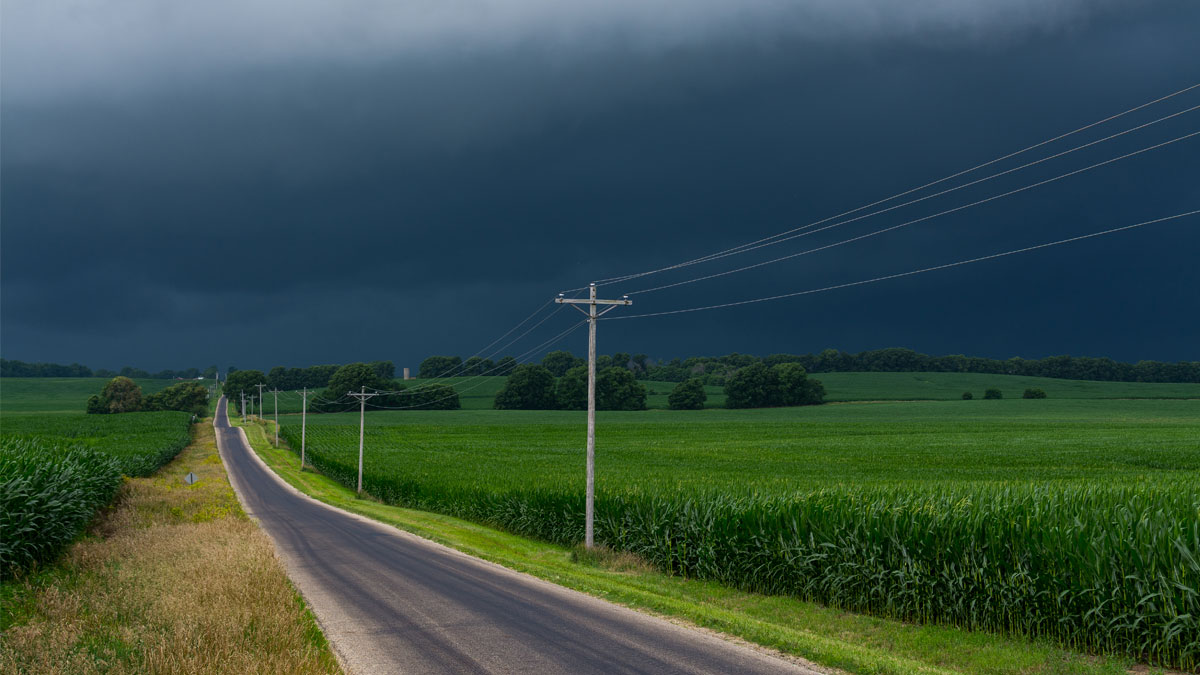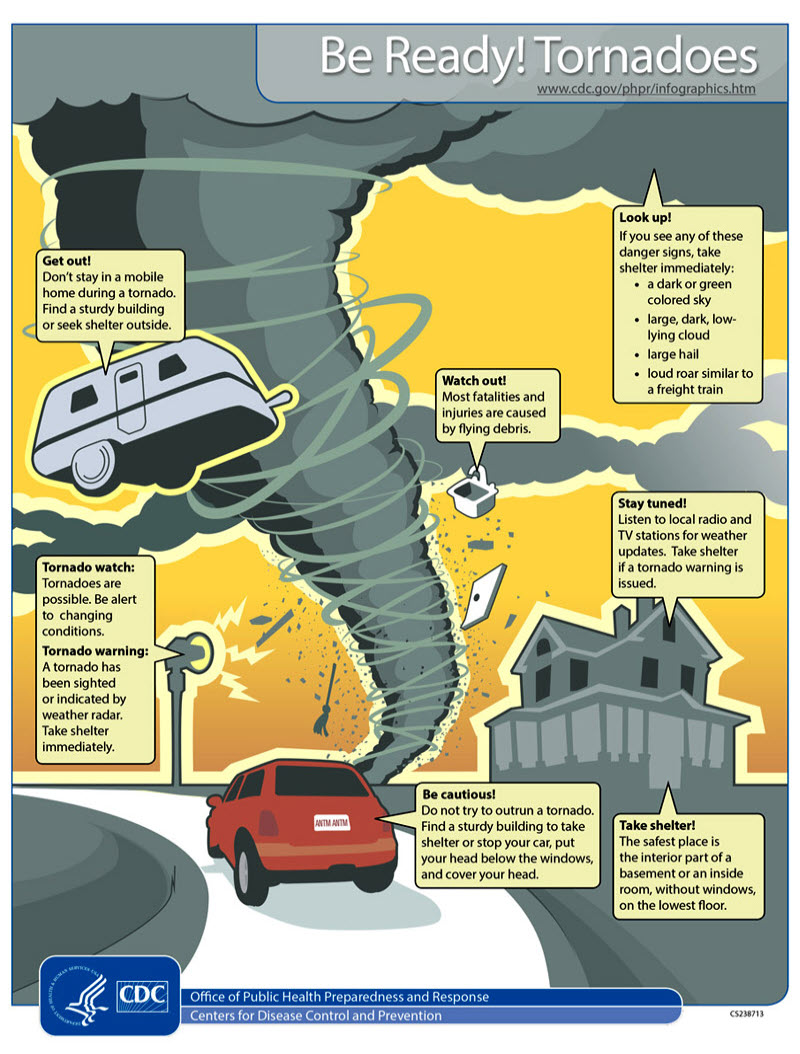Preparing for a Tornado

Tornadoes impact locations across the country every year, bringing massive winds and destruction in their paths. Although tornadoes are most common in the Central Plains, the Midwest, and the Southeast, they have been reported in all 50 states. Keep yourself and your loved ones safe by preparing in advance for tornadoes.
Know the signs of a tornado.
Some tornadoes strike quickly without time for a tornado warning, so it is important to know the signs of a tornado.
Signs that a tornado may be approaching include the following:
- Rotating funnel-shaped cloud
- Approaching cloud of debris
- Dark or green-colored sky
- Large, dark, low-lying cloud
- Large hail
- Loud roar that sounds like a freight train
If you notice any of these signs take cover immediately and stay tuned to local radio and TV stations, a NOAA weather radio, or the internet.

Download Infographic PDF: English | Español
Stay tuned for thunderstorm watches and warnings.
Tornadoes often accompany thunderstorms. When there are thunderstorms in your area, turn on your radio or TV to get the latest emergency information from local authorities or check your mobile phone for weather alerts. Pay close attention to changing weather conditions when there is a severe thunderstorm watch or warning.
- A severe thunderstorm watch means severe thunderstorms are possible in your area.
- A severe thunderstorm warning means severe thunderstorms are occurring in your area.
Know the difference between a tornado watch and a tornado warning.
Tornado watch
A tornado watch means that a tornado is possible. A tornado watch is issued when weather conditions favor the formation of tornadoes.
During a tornado watch, you should:
- Stay tuned to local radio and TV stations, a National Oceanic and Atmospheric Administration (NOAA) Weather Radio , or your mobile phone for further weather information.
- Watch the weather and be prepared to take shelter immediately if conditions worsen.
Tornado warning
A tornado warning means that a tornado has been sighted or indicated by weather radar. You should immediately take shelter during a tornado warning.
NOAA Weather Radios
NOAA weather radios remain the best way to receive warnings from the National Weather Service. By using a NOAA weather radio, you can receive continuous updates on all the weather conditions in your area.
The National Weather Service recommends buying a radio with a battery backup (in case the power goes off) and a tone-alert feature that automatically sounds when a weather watch or warning is issued.
Learn your local tornado warning system.
Learn about the tornado warning system of your county or locality. Most tornado-prone areas have an outdoor siren system. Know how to distinguish between the siren's warnings for a tornado watch and a tornado warning.
Wireless Emergency Alerts (WEAs) are another method to stay up to date on weather emergencies. WEAs are emergency messages sent by authorized government authorities, such as the National Weather Service, through your mobile carrier. The alerts look like a text message and typically show the type and time of the alert, any action you should take, and the agency issuing the alert. For more information, visit the National Weather Service website.
Identify the safest place to take shelter.
Although there is no completely safe place during a tornado, some locations are safer than others. Safe places include:
- A storm cellar
- A basement
- And inside room without windows on the lowest floor (such as a bathroom, closet, or center hallway)
If you live in a mobile home, identify a nearby building you can get to quickly. Don't stay in a mobile home during a tornado. If you live in a tornado-prone area, encourage your mobile home community to build a tornado shelter.
Plan ahead
Create a tornado emergency plan.
Take a few minutes to develop a tornado emergency plan.
- Identify a safe place in your home for household members and pets to gather during a tornado.
- Make sure everyone understands the tornado warning system in your area.
- Teach your family how to administer basic first aid, how to use a fire extinguisher, and how and when to turn off water, gas, and electricity in your home.
- Learn the emergency dismissal policy for your child's school.
Sketch a floor plan of your home or walk through each room and discuss where and how to seek shelter.
- Identify a second way to exit from each room or area. If you need special equipment, such as a rope ladder, mark where it is located.
- Mark where your first-aid kit and fire extinguishers are located.
- Mark where the utility switches or valves are located so they can be turned off (if time permits) during an emergency.
Prepare your children.
Make sure your children know:
- What a tornado is
- What tornado watches and warnings are
- What county or parish they live in (warnings are issued by county or parish)
- How to take shelter, whether at home or at school
Extra measures for people with functional needs:
- Write down your specific needs, limitations, capabilities, and medications. Keep this list near you always—perhaps in your purse or wallet.
- Find someone nearby (such as a spouse, roommate, friend, neighbor, relative, or co-worker) who will agree to assist you in case of an emergency. Give them a copy of your list. You may also want to provide a spare key to your home, or directions to find a key.
- Stay up to date on the weather conditions through whatever means are accessible to you. Some options are closed captioning or scrolled warnings on TV, radio bulletins, or call-in weather information lines.
Write down important information.
Make a list of important information, including the following:
- Emergency telephone numbers (such as police, fire, paramedics, and medical centers)
- Names, addresses, and telephone numbers of your insurance agents, including policy types and numbers
- Telephone numbers of the electric, gas, and water companies
- Names and telephone numbers of neighbors
- Name and telephone number of your landlord or property manager
- Important medical information (for example, allergies, regular medications, and brief medical history)
- Year, model, license plate, and identification numbers of your vehicles
- Telephone number for your bank or credit union, and your account numbers
Store important documents, such as the following, in a fireproof and waterproof safe:
- Birth certificates
- Ownership certificates (for example, autos or boats)
- Pet registrations or other proof of ownership
- Passports
- Medical documents
- Social security cards
- Insurance policies
- Will
- Household inventory
- List of household items, including serial numbers, if applicable
- Photos or videos of the contents in each room
- Photos of high-value items, such as jewelry, paintings, or collection items
Create an emergency supply kit.
Stock up on emergency supplies that can be used after a tornado. These supplies should include a first aid kit and emergency supply kits for the home and automobile , including emergency water and food. Store enough supplies to last at least 3 days.
Create a pet disaster preparedness kit if you have pets. You should include items such as veterinary records; registration information; a 2-week supply of water, food, and medications; a leash; and a pet carrier. For more information on how to prepare your pets for a disaster, see CDC's Pet Safety in Emergencies website.
Practice your emergency plan.
Conduct drills and ask questions to make sure your loved ones remember information on tornado safety, particularly how to recognize hazardous weather conditions and where to take shelter.
Get rid of hazards inside and outside your home
The following suggestions will reduce the risk for injury during or after a tornado. However, no amount of preparation will eliminate every risk.
Inspect your home for possible hazards.
Inspect your home for possible hazards. Address these questions:
- Are walls securely bolted to the foundation?
- Are wall studs attached to the roof rafters with metal hurricane clips, not nails?
- Are chairs or beds near windows, mirrors, or large pictures?
- Are heavy items stored on shelves more than 30 inches high?
- Are there large, unsecured items that might topple over or fall?
- Are poisons, solvents, or toxic materials stored safely?
Secure your home's structure.
No home is completely safe in a tornado. However, attention to construction details can reduce damage and provide better protection for you and your loved ones. For example, you may need to strengthen the areas of connection between the wall studs and roof rafters with hurricane clips.
If you identify a possible hazard in the way your home is constructed, contact your local city or county building inspectors for more information about structural safety. They may also offer suggestions on finding a qualified contractor to do any needed work for you.
Arrange and secure household items.
Make sure to inspect your home and its surroundings for any possible hazards and secure them if you can:
- Arrange furniture so that chairs and beds are away from windows, mirrors, and picture frames.
- Place heavy or large items on lower shelves.
- Secure your large appliances, especially your water heater, with flexible cable, braided wire, or metal strapping.
- Identify top-heavy furniture, such as bookcases and china cabinets, that could topple over. Secure them with "L" brackets, corner brackets, aluminum molding, or eyebolts.
- Secure cabinet doors by installing sliding bolts or childproof latches.
- Store hazardous materials such as poisons and solvents in a sturdy, locked cabinet in a well-ventilated area. Keep them away from your emergency food and water supply and out of reach of children and pets.
Remember outdoor items.
- Make a list of items to bring inside in the event of a storm.
- Remove any debris or loose items in your yard.
Learn how to shut off utilities.
- Know where and how to shut off utilities, including gas, electricity, and water, at the main switches or valves. Check with your local utility companies for instructions.
- Teach all family members how and when to shut off utilities.
- Visit Safety Skills: Ready.gov to learn more.
Resources
- Natural Disasters and Severe Weather
- Hurricanes and Other Tropical Storms
- Tornadoes | Ready.gov
- Tornado Safety (weather.gov)
- Tornado Safety Tips | Tornado Preparedness | Red Cross



